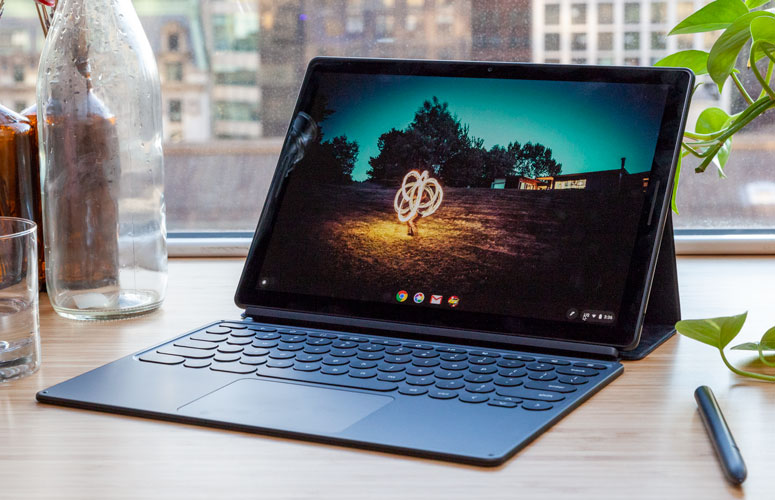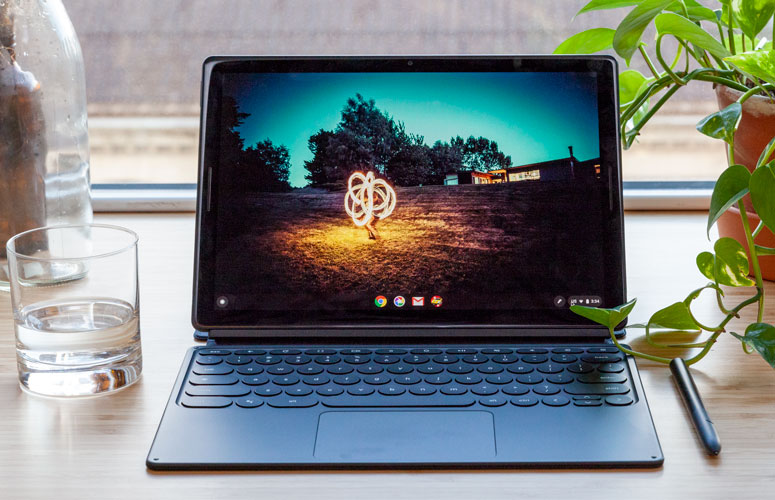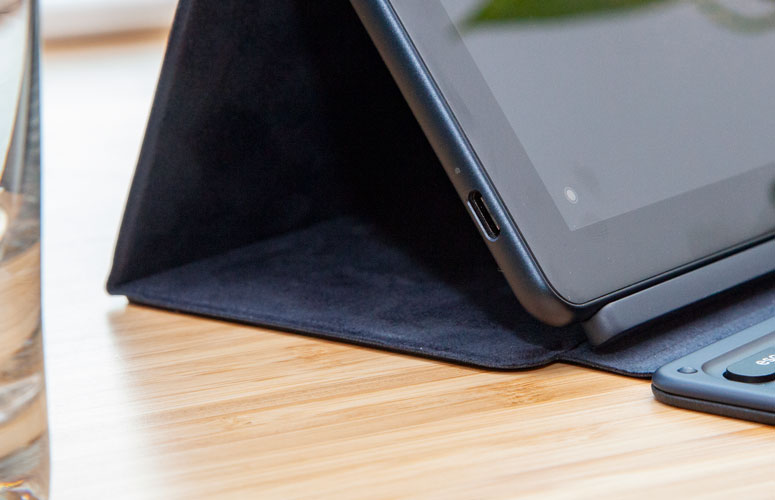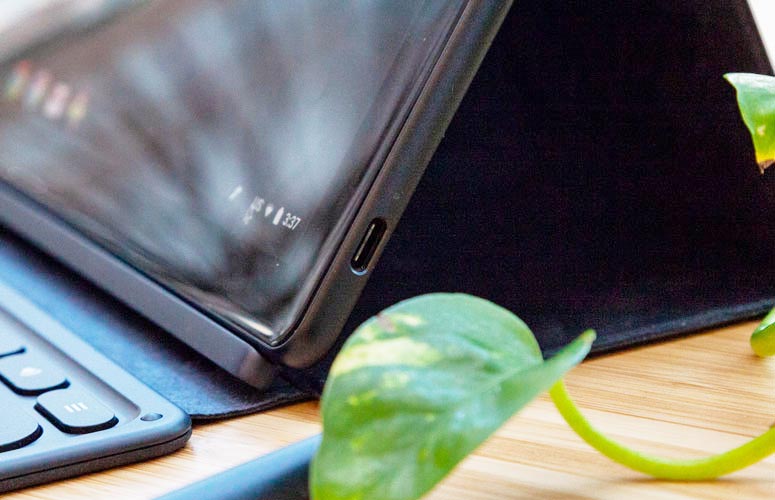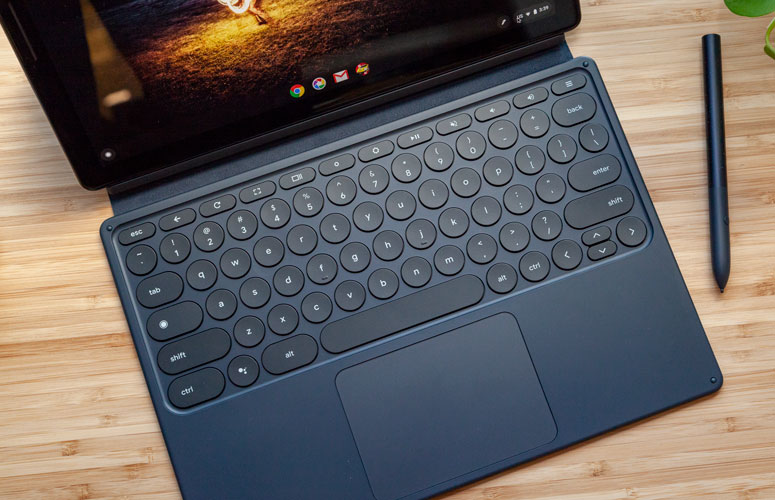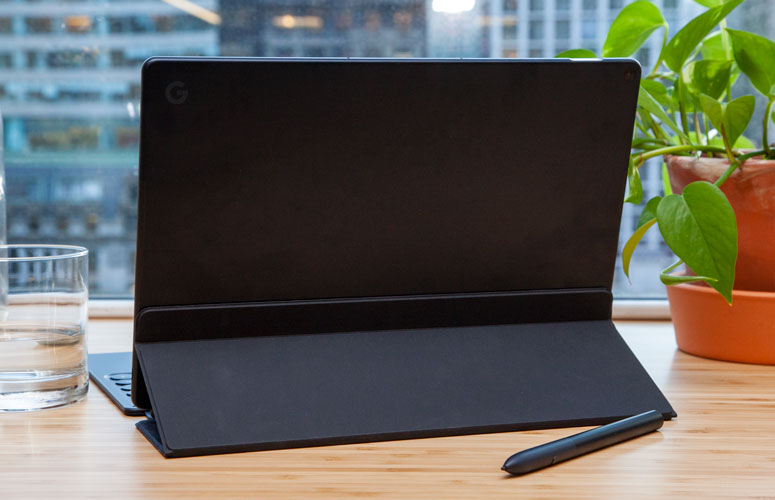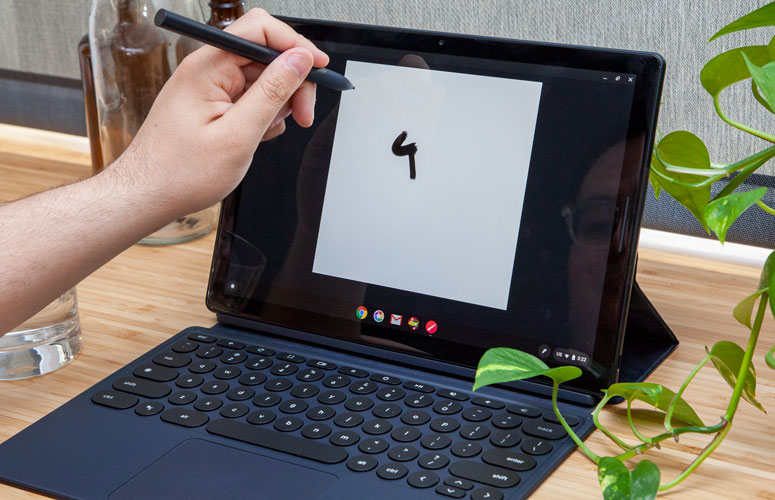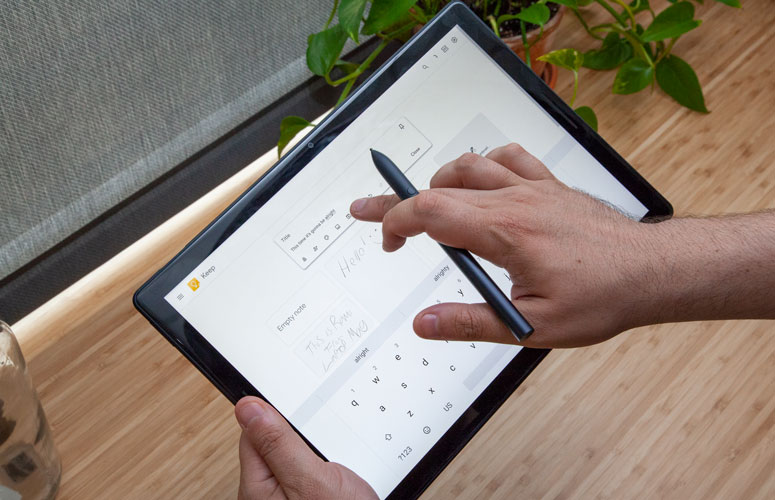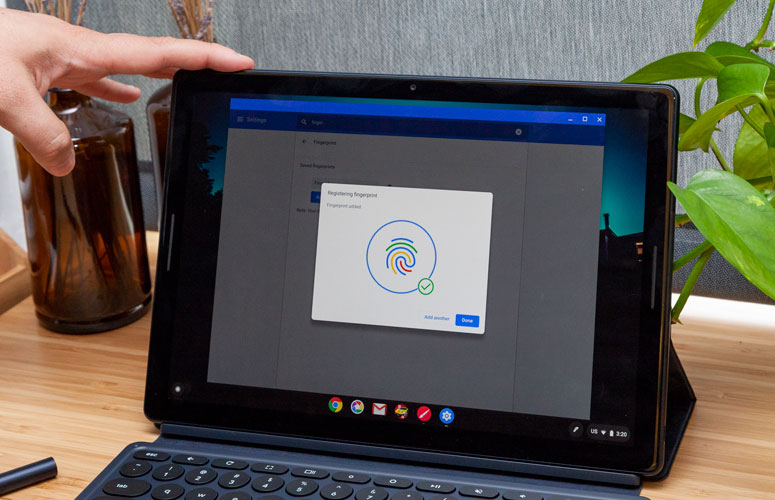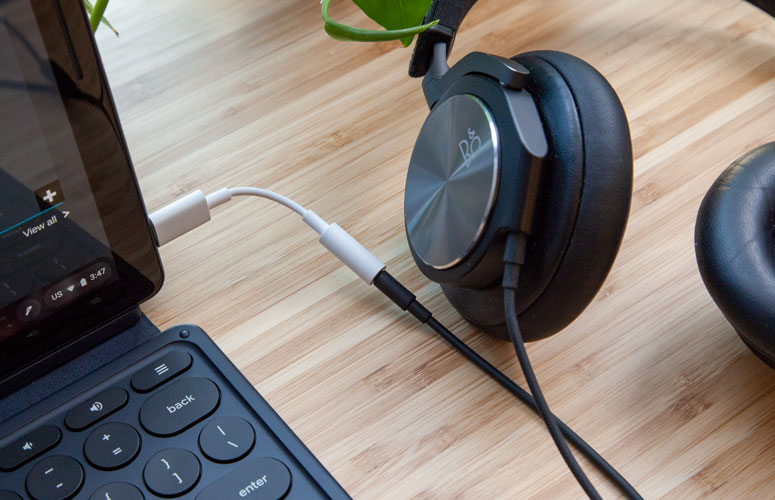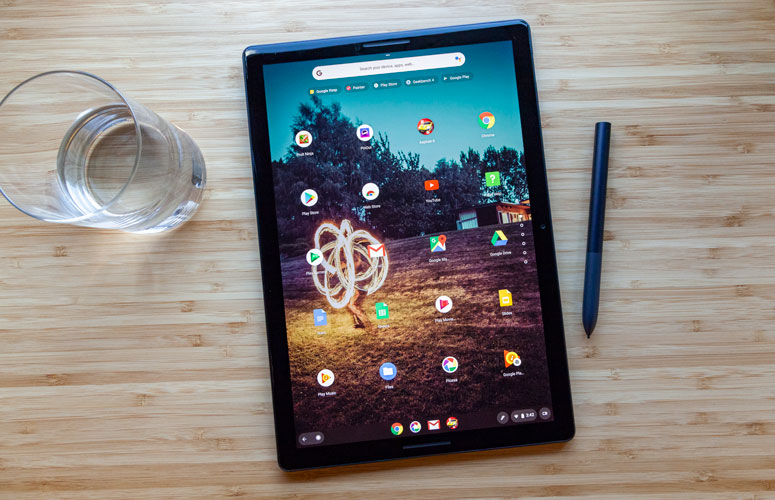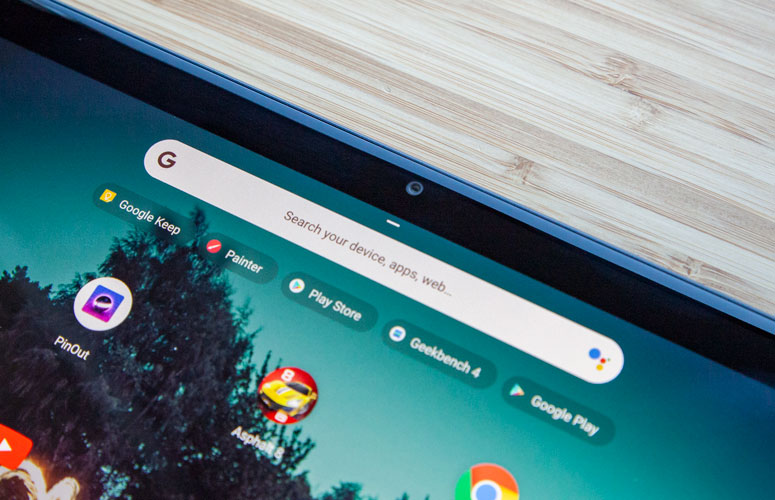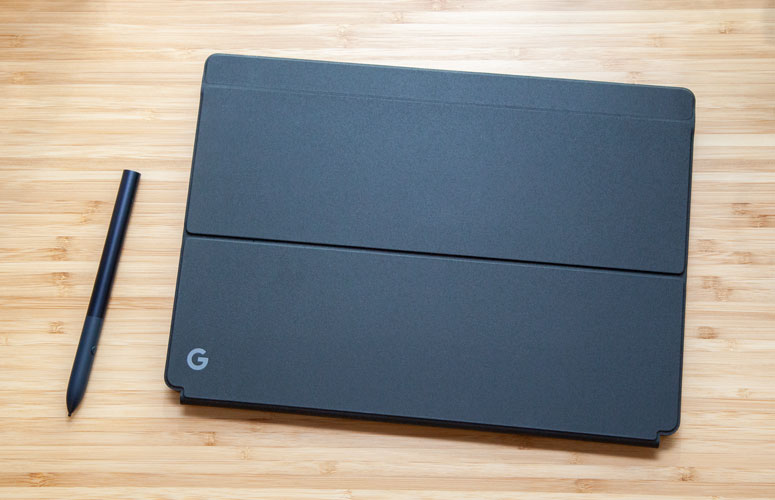Laptop Mag Verdict
The Google Pixel Slate is a great 2-in-1 with small issues that Google needs to fix.
Pros
- +
Elegant design
- +
Sharp, vibrant screen
- +
Optional keyboard is both comfy and offers many angles
- +
Excellent handwriting recognition
- +
Great audio
- +
Nearly 10 hours of battery life
Cons
- -
Buggy Bluetooth problems
- -
Keyboard adds heft
- -
Android apps on Chrome OS still a work in progress
- -
Expensive
Why you can trust Laptop Mag
Editor's Note on July 20, 2021: The Pixel Slate has been discontinued and replaced by the clamshell Pixelbook Go. Google won't be making another Pixel Slate as the company is no longer making tablets and detachables.
The Google Pixel Slate is Google's next chapter of Chrome OS after the search engine giant launched its own pricey Chromebook: the Pixelbook. The Pixel Slate (starting at $599, tested at $999) is a 12.3-inch tablet with attachable keyboard (optional, $199).
Chrome OS has been updated to meet this challenge, with new tricks including natural writing recognition and interface features borrowed from Android. Also, the Pixel Slate packs a great screen and solid sound. Unfortunately, for as much as Chrome OS is growing, some Android apps still don't quite look right, and the Pixel Slate's also got a couple of bugs that we hope get fixed soon.
And while the effortless security of Chrome OS might be worth the same amount of cash you'd spend on a Surface Pro 6 or a very good ultraportable laptop, these small bugs make for a device we can only recommend to those ready to handle a bumpy road. If Google fixes these issues, though, the Pixel Slate might be ready for the mass market.
Google Pixel Slate price and configuration
While the Google Pixel Slate starts at $599 -- with an Intel Celeron CPU, 4GB of RAM and 32GB of storage -- we tested the $999 configuration that rocks an Intel Core i5 processor, 8GB of RAM and 128GB of storage. On top of that, you'll want the $199 Pixel Slate Keyboard and those who prefer to write longhand and draw should check out the $99 Pixelbook Pen.
While that much storage may feel like overkill on the cloud-based Chrome OS, you can't save by getting a Slate with a Core i5 processor with 64GB of storage, as that much space is only available in the Core m3 version. If you're looking to use this as your main machine, I would not recommend relying on the Core m3 CPU, unless your needs are minimal to moderate.
On top of all of that, you may want to consider Google's additional Preferred Care warranty. For $149 extra, Google will toss in 24x7 technical support, an extra year of hardware coverage (on top of the included 1-year manufacturer warranty) and two claims of accidental damage repairs under a 2-year period. As such, my recommended configuration costs $1,198.
Sign up to receive The Snapshot, a free special dispatch from Laptop Mag, in your inbox.
Google Pixel Slate design
The dark Midnight Blue of the Google Pixel Slate gives it a hint of elegance while allowing it to blend in seamlessly to a modern office. Further, its anodized aluminum chassis feels strong and durable. The Pixel Slate's bezels look a tad chunky, especially compared to those of the new iPad Pros, but the black bars aren't big enough to make it look dated.
At 1.6 pounds and 0.3 inches thick, the Pixel Slate (without keyboard) is slightly lighter than the Microsoft Surface Pro 6 (1.7 pounds, 0.3 inches) and the Samsung Galaxy Book 2 (1.8 pounds, 0.3 inches), and heavier and thicker than the 2018 12.9-inch iPad Pro (1.4 pounds, 0.2 inches).
The Pixel Slate feels a little less portable when attached to Google's Pixel Slate keyboard, which nearly doubles its weight to 2.9 pounds, and doubles its thickness to 0.6 inches. This makes it heavier and thicker than the Google Pixelbook (2.5 pounds, 0.4 inches thick), and the Galaxy Book 2 and Surface Pro 6 are both about half a pound lighter when paired with their attachable keyboards.
Google Pixel Slate ports
Hey, Apple: you could learn a lesson from the dual USB Type-C ports in the Pixel Slate. Not only does this slate pack one more than the new iPad Pros, these actually support external storage (the iPad Pro doesn't), so the Pixel Slate can actually fit into a modern working environment, rather than just rely on cloud storage. That being said, both machines beat the Surface Pro 6, which requires an $80 adapter for a Type-C port.
One annoying glitch I found in that external device support, though: after importing large, multi-gigabyte files to the Pixel Slate, it appears to crash and reboot, with the screen going dark for a moment before opening a blank Chrome tab. Aside from that, the file transfer works correctly, though.
You connect the Pixel Slate to the Pixel Slate Keyboard using the company's proprietary Pogo port, found on its bottom edge. Google includes a Type-C to 3.5 millimeter audio adapter, as the Pixel Slate doesn't include a headphone jack.
Google Pixel Slate display
The Google Pixel Slate's 12.3-inch screen offers great color and detail. As I watched a remastered version of the 1977 film Suspiria on the Pixel Slate, I noticed excellent reproduction of the shining gold that adorns the dance academy's facade and the intense red that floods across Suzy Bannion throughout the film, as well as strong verdant greens for the ferns in the school's lobby. I also saw a ton of crisp details in the Slate's 3,000 x 2,000-pixel panel, including the tinier ripples of the school's pool and the texture of the lobby's blue velour walls.
The Pixel Slate's screen produces 120 percent of the sRGB color spectrum, which narrowly leaps over the 116 percent average and 117 percent rating from the Pixelbook. Slightly higher ratings came from the Surface Pro 6 (136 percent) and iPad Pro (128 percent), while the Galaxy Book 2's screen boasts a much higher 200 percent rating.
The Pixel Slate gets pretty bright, emitting up to 337 nits, which beats the 316-nit premium laptop average and comes close to the 350-nit Galaxy Book 2. We found brighter screens in the Surface Pro 6 (408 nits), iPad Pro (484 nits), and Pixelbook (421 nits). The Pixel Slate's brightness is strong enough for decent viewing angles, as I saw colors stay strong, and not darken, when viewed at 35 degrees to the left and right.
MORE: Best 2-in-1s - Laptop/Tablet Hybrids - Laptop Mag
The Pixel Slate's 12.3-inch screen offered accurate touch recognition as I navigated the web and smooth scrolling as I skimmed through the Google Doc for this review. It also responds to swipe-up gestures from the bottom and top, with the former opening the app shelf and the latter showing all open apps and enabling split-screen apps (but only when you're in tablet mode).
Some users have reported sluggish, stuttery performance in tablet mode, and it appears that Google will fix this issue in Chrome OS 75.
Google Pixel Slate keyboard
The backlit Pixel Slate Keyboard (optional, $199 extra) is a joy to type on, and probably one of my favorite 2-in-1 keyboards yet. Not only did I breezily click my way to 75 words per minute on the 10fastfingers typing test (not far from my 80 wpm average), but it took me no time at all to get used to its circular key caps, which worried me when Google first revealed the Slate as some circular keys become a pain. I bet my colleagues would prefer I switch to the Slate, as Google's super-quiet 'Hush' keys muffled the sound of my typically loud typing.
The Pixel Slate Keyboard's 4.0 x 2.8-inch touchpad accurately tracked my input. It also provided smooth scrolling as I skimmed the Google Doc for this review and responded to three-finger swipe gestures for viewing all open windows, a trick I tried out on a whim, checking to see if Google was aiming for parity with Windows 10 and macOS.
Pixel Slate Keyboard's reclining folds allow for far more positions than most folding folios, getting closer to the range of the kickstand-based Surface Pro. So, instead of the two positions that the iPad Pro's Smart Keyboard Folio adjusts between, you can to move from 135 degrees to almost 90 degrees.
The backlit Pixel Slate Keyboard (optional, $199 extra) is a joy to type on, and probably one of my favorite 2-in-1 keyboards yet.
Oh, and since the Pixel Slate Keyboard uses magnets to attach to the back of the Slate, you'll find the folding flaps can attach quite hard when near any metal surfaces. I discovered this at a Starbucks, where I could remove the keyboard from with some effort, though I couldn't slide it around the table.
As I drew with the Google's Pixelbook Pen (optional, $99 extra) in Infinity Painter, I was impressed enough to call my editor Michael Andronico over and say "check this out, it's a pretty damn good stylus!" Not only does the pen draw with nearly no latency, and a seriously natural feel when pressing the tip against the Pixel Slate's screen.
The Pen offers 2,048 levels of pressure sensitivity, which is half as much as you get with the Galaxy Book's S Pen and the Surface Pen (both 4,096), while Apple doesn't specify the pressure sensitivity of the Apple Pencil.
I found mixed results while testing out the Pen's Google Assistant feature, where holding its button while circling an image asks the AI for help identifying the thing or person you circled. Circling multiple faces in a photo about mixed martial arts, Assistant correctly identified the athletes Anderson Silva and Ronda Rousy, but failed to get UFC honcho Dana White, instead suggesting he was John Cena (who you can't see, but that's neither here nor there).
MORE: Google's Pixel Slate Not Shipping Until December
The biggest difference in Google Assistant in Chrome OS today vs Google Assistant back when the Pixelbook came out is that the results now arrive much faster. Google claims the speed is improved by 350 percent. I still don't exactly know when I'd use this feature in everyday activity, but it certainly is a neat trick.
Google Pixel Slate Chrome OS
If the Pixelbook exemplified Chrome OS's potential as a laptop, the Pixel Slate proves that Google's experience in Android is great for a touch-based experience. In particular, the settings and notifications menu, opened by tapping the bubble with the time in the bottom right corner, has been overhauled to a fantastic degree. Now, it looks just like the pull-down settings menu in a Pixel phone, and the system notifications also look just like those from an Android device.
My favorite new feature in Chrome OS is Google's on-screen keyboard. Don't overlook the little squiggle in the top of the on-screen keyboard that you get in tablet mode: tapping on that opens up handwriting mode, which will allow you to type by hand-writing (or doodling) letters with a finger or stylus. Watching it convert text on the fly, faster than Windows does with its similar mode, was neat to see.
One of the biggest reasons why I think the Pixel Slate is a solid laptop-replacement is its Type-C port, which supports all sorts of external devices. When I used a Type-C to USB 3.0 adapter to plug the Slate into my setup at home, all of my external drives showed up, as did my Blue Yeti USB Microphone I use for podcasting and my Audioengine 2+ speakers. While the iPad Pro can do a lot of that of those, it doesn't support generic external storage, which leaves everyone with external drives in the cold.
Also, if you're a Pixel-owner (I'm not), you'll benefit from new tricks. For example, Android Messages is now baked into Chrome OS, and a Pixel phone can unlock a Pixel Slate (or Pixelbook) with a single tap if they're owned by the same person. These are the kind of perks that those in the Apple ecosystem will find familiar, and those who live the Google life will appreciate.
The one sore spot is that Android app emulation on Chrome OS -- especially with a screen this huge -- makes it feel like you're using a giant phone instead of a tablet.
And at the center of the Pixel Slate, you find the reliable Chrome browser, which I mention because it's a much more complete experience than the Mobile Safari that you get on the iPad Pro. When I tried to use the iPad Pro as my main computer, I ran into multiple issues trying to connect to our servers and open the websites we rely on for producing content. Pages, I should add, that opened smoothly on the Pixel Slate.
The other major reason that will push some from Windows to Chrome OS is Google's no-nonsense approach to updates and security. Not only does Chrome perform all of its system-level maintenance in the background, but it also runs updates only when you restart the system, so you never lose anything.
The one sore spot here is that Android app emulation on Chrome OS -- especially with a screen this huge -- makes it feel like you're using a giant phone instead of a tablet. Some apps (including Instagram and the games Alto's Odyssey and PinOut) only let you do full screen mode and possibly, a smaller, more phone-like screen (if you're lucky), and touch targets are often a bit too tiny for casual taps, and made me feel like I was shooting an arrow at a small target. And the type in Discord is way too tiny on the Pixel Slate's screen.
MORE: Google Pixel Slate vs. Pixelbook: Which Should You Buy?
Since tablets seem to be the next frontier for Chrome OS, I assume that Google will be asking app developers to consider this in the future, but its own team needs to get the memo, as the YouTube Android app on Chrome OS has all of those same problems, plus an awkward issue where I kept finding a slight white hue brightening the screen, because it had been 'selected' in the UI, which was hard to stop.
Google Pixel Slate Bluetooth trouble
I found a pair of odd, annoying issues when listening to music on the Pixel Slate with Bluetooth headphones and use it with a Bluetooth keyboard. First of all, my music kept dying. Specifically, the connection to my headphones -- first with my Apple AirPods and then with the Bose QuietComfort 35 -- just dropped. Sometimes I'd have to manually re-pair the connection, and once, the connection fixed itself after a moment. I've reached out to Google to see if there's a fix and will update this review when one becomes available.
I experienced serious Bluetooth issues that caused music to cut out on my headphones, but Google promises a fix.
The second issue is even odder: sometimes the Bluetooth setting in the options menu just disappeared. Opening the Settings app doesn't help, as Bluetooth wouldn't turn on there either. The only solution is to the reboot the Pixel Slate.
A Google representative told me "We've received reports about intermittent Bluetooth issues with select headsets and are working on a fix as soon as possible." I expect the company to solve these issues soon, as they're not the kind of issue you should have on a tablet that starts at $599 and costs up to $1,599. While these bugs are pretty surprising when Pixel phones don't exhibit this issue, Google's Pixel C tablet did have Bluetooth issues related to its keyboard.
Google Pixel Slate audio
The Google Pixel Slate is a solid jambox. As I streamed tracks from the band Idles on the slate, I managed to fill a dining room, as well as two adjacent rooms with post-punk group's heavy riffs and belting vocals, and even muffle the laundry machines going upstairs. Not only does the Pixel Slate pump out a lot of volume from its two front-firing speakers, that audio sounds pretty sweet, with heavy drum beats sounding sturdy and vocals coming out accurately.
Google Pixel Slate performance
We tested a Google Pixel Slate outfitted with an 8th Gen Intel Core i5-8200Y processor and 8GB of RAM, a configuration that provides enough speed for decent productivity. I saw no performance dip after splitting my screen between a 1080p YouTube video and a dozen Chrome tabs (including the Google Doc for this review, Gmail and Giphy). The performance stayed stable as I kept Twitter, 1Password, and Discord open in the background, switching between them using the Alt+Tab keyboard shortcut.
Over on the Geekbench 4 general performance test (run via Android emulation thanks to the Google Play Store) the Pixel Slate turned in a less-than-thrilling 8,071, which falls below the 12,792 premium laptop average, and narrowly beats the 7,927 from the Pixelbook (Core i5-7Y57 with 8GB of RAM). We saw higher scores of 13,761 from the Surface Pro 6 (Core i5-8250U with and 8GB of RAM) and 17,995 from the iPad Pro (A12X Bionic chip with Neural Engine Embedded M12 coprocessor), and a lower 3,575 from the Galaxy Book 2 (Snapdragon 850 with 4GB of RAM).
The JetStream test for Javascript performance gave the Pixel Slate a score of 146.84, which is low, but not terrible, falling well below the 1,016.22 average, but beating the Galaxy Book 2 (101). We saw higher scores from the Surface Pro 6 (215.74) and iPad Pro (279), and while the original Pixelbook scored a 145.09, we re-ran the test on that same Pixelbook, which now earns a 128.66. The Samsung Galaxy Book 2 hit 101.
The Pixel Slate ran the 5,000 fish round of the WebGL Aquarium simulation -- which renders hundreds to thousands of animated fish -- at about 28 frames per second. The Pixelbook ran at the same rate.
MORE: Google Pixel Slate vs. Apple iPad Pro: Which Should You Buy?
The Slate's gaming limitations revealed themselves when I tried out PUBG Mobile, which defaulted to the lowest graphics setting. Even then, I saw stutter and clipping, and the game ran in a pixelated mode that didn't look that great. More casual games, though, such as the futuristic pinball title PinOut, ran super smooth.
Google Pixel Slate battery life
The Google Pixel Slate lasts for a reliably long amount of time. Specifically, the Pixel Slate lasted 9 hours and 51 minutes on the Laptop Mag Battery Test (web browsing at 150 nits), a time that beats the 8:13 average by more than 1.5 hours. The Surface Pro 6 (9:20) fell half an hour short, while the iPad Pro (13:14) and Galaxy Book 2 (10:41) made it longer. The Pixel Slate also outlasted the Pixelbook (7:43), which was tested at a less-demanding 100 nits rate.
Google Pixel Slate webcam
Nobody with any sense will ever say you should use a tablet as a main camera, but the Google Pixel Slate's lenses take decent shots.
The 8-megapixel rear shooter captured the blues and pinks of an ice cream truck correctly, though the lighting from the truck created blown-out spots. The Slate's 8-megapixel selfie cam is equally capable, nailing the finer details in my hair, the texture of my bag's woven straps and even capturing a small amount of stubble on my chin.
Google Pixel Slate heat
The Pixel Slate can get a little warm, but you won't notice that in the laptop mode.
After we streamed 15 minutes of HD video on it, our heat gun picked up temperatures of 80 degrees Fahrenheit on its touchpad and 82 degrees on its keyboard, while the back of the tablet rang up to 94 degrees, the only spot even close to our 95-degree comfort threshold.
Bottom line
There so much about the Google Pixel Slate to love, including its beautiful screen, comfortable keyboard, great sound and long battery life. Unfortunately, this machine comes with a few asterisks, including some notable bugs that Google should fix soon. It will take longer, though, for Google Play apps to feel like native tablet apps.
If performance and battery life are your top priorities, check out the 12.9-inch iPad Pro ($999 with optional $199 keyboard), but realize that iOS may not have everything you need to replace your current laptop, especially if you use external storage or prefer to have a touchpad. If you prefer Windows, check out the Surface Pro 6, which costs $1,128 with keyboard and pen.
Right now, I'd say that the Pixel Slate feels like a device for the adventurous types who love Android and Chrome, and are OK with some first-gen bugs. Once those issues are cleared, though, Google's got an excellent 2-in-1 on its hands.
Credit: Laptop Mag
Google Pixel Slate Specs
| Bluetooth | Bluetooth 4.2 |
| CPU | 8th Gen Intel Core i5-8200Y processor |
| Display Size | 12.3 |
| Hard Drive Size | 128GB |
| Highest Available Resolution | 3000 x 2000 |
| Native Resolution | 3000 x 2000 |
| Ports (excluding USB) | USB Type-C |
| RAM | 8GB |
| Size | 11.5 x 8 x 0.3 inches, 0.6 inches docked |
| Touchpad Size | 4.0 x 2.8 |
| USB Ports | 2 |
| Warranty/Support | 1-year limited hardware warranty |
| Weight | 1.6 pounds, 2.9 pounds docked |
| Wi-Fi | 802.11 a/b/g/n/ac |
| Wi-Fi Model | 802.11 a/b/g/n/ac, 2x2 (MIMO), dual-band (2.4 GHz, 5.0 GHz) |
Henry was a contributing writer at Laptop Mag. He penned hundreds of articles, including helpful how-tos for Windows, Mac, and Gmail. Henry has also written about some of the best Chromebooks, and he has reviewed many Apple devices, including various MacBook Air laptops. He is now a managing editor at our sister site Tom's Guide, covering streaming media, laptops, and all things Apple.
